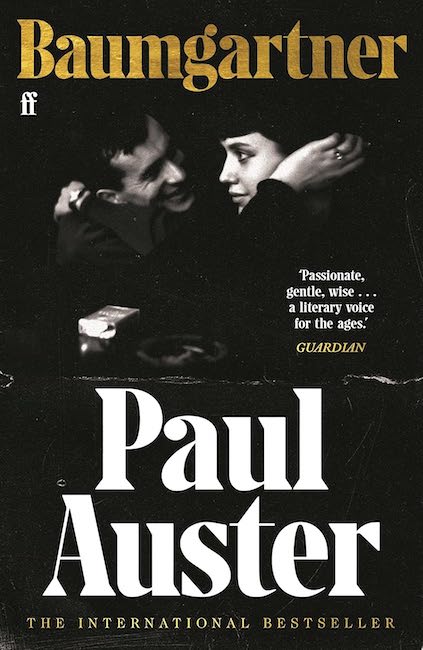
I chose Auster’s last novel as the buddy read for Paul Auster Reading Week. Published in 2023, a slim novel at just over 200 pages, it didn’t disappoint and revisits many of his favourite themes. The first chapter sets a comic scene.:
Baumgartner is sitting at his desk in the second-floor room he variously refers to as his study, his cogitorium, and his hole. Pen in hand, he is midway through a sentence in the third chapter of his monograph on Kierkegaard’s pseudonyms when it occurs to him that the book he needs to quote from in order to finish the sentence is downstairs in the living room, where he left it before going up to bed last night. It also occurred to him that he promised to call his sister this morning at ten o’clock, and since it is almost ten now, he will go into the kitchen and make the call before retrieving the book from the living room.
But he won’t make the call…
- He’d left a pan on the gas making his coffee earlier, and burns his hand taking it off.
- The doorbell rings: it’s his regular delivery of books he’d ordered arrive via the UPS lady Molly, who he always chats to.
- The phone rings: but even though it’s now 1015, it’s not Naomi – it’s Rosita, the 12-year-old daughter of Mrs Flores his cleaner to tell him that Mr Flores has had an industrial accident, cutting two fingers off, so her mother won’t be in today. He reassures the sobbing girl that they can sew the fingers back on these days.
- The doorbell rings again: it’s the meter-reader apologising for being late. Ed is rather garrulous, and eventually Baumgartner shows him into the cellar – going first down the rickety stairs – and falling, injuring his knee. Ed carries him up and after assessing him for consciousness, much to Sy’s (they’re on first name terms now) amusement amid the pain – promises to return later to help him.
He falls asleep, book and call forgotten. Amazingly, Ed does return, and Baumgartner is thankful for his help and friendship – Ed will return later.
It’s a great opening. It’s unusual for Auster to be so sustainedly comic, even farcical, over these twenty-five pages, but it gives us an insight into the life of Seymour ‘Sy’ Baumgartner; retired Princeton professor and author, living alone and sometimes lonely, but still writing, denying the gradual decay around him, occasionally forgetting, easily distracted. There is poignancy there though, which will amplify over subsequent chapters as he looks back over his life.
In the second chapter, we get to know Baumgartner’s late wife Anna a little. She died ten years ago in a freak wave accident at the beach, he has always regretted that when she’d said she was going back in the sea, that he hadn’t persuaded her to stay. She was a writer too, and her office, maintained as a shrine is full of her work still. She favoured an old-fashioned typewriter over newer technology and had an old red telephone that he dreams she rang him on. Moving stuff, but the dream frees him from his overpowering grief, and he decides to publish a book of her poems. A particularly touching paragraph shows him obsessively folding and refolding Anna’s underwear soon after she died, while he was in limbo.
It’s in this section that Auster introduces, in book within a book style, an essay by Anna that Baumgartner finds and sits reading about her first real boyfriend, Frankie Boyle. (No, not that Frankie Boyle!). This was the time of ‘Nam – ’nuff said. This is the first of three such interludes, a second piece finds Anna writing about hers and Sy’s early days together culminating with his proposal. A romantic piece, but not without its drama in an incident which shows Anna’s character. A third essay chronicles Sy’s visit to the Ukraine to seek out his family history, which combines a well-intentioned kind lady guide and a potentially shaggy dog story by a local poet about ‘The Wolves of Stanislav’.
This last essay follows Baumgartner recalling memories of growing up, of the family business and breaking free. It also names Baumgartner’s mother as a ‘Ruth Auster’, although I know of no Ruth in Auster’s own close family. Previous chapters also looked at how he started dating again, and Judith, the well-heeled divorcee and old friend he’s comtemplating asking to grow old with him.
After that bravura opening, the novel settles down, like its protagonist, into a life of multiple threads and lesser dramas together with constant distractions until Auster engineers a rather sudden ending, cleverly leaving many ends untied as normal life would do. This is a novel of an ordinary life perhaps, but its easy to believe that Sy and Anna had an extraordinarily strong relationship. Despite being the scholarly philosopher, I found Sy to be empathetic and likeable, and maybe there’s a bit of Paul Auster in him too.


In summary, Baumgartner is a gentle read and a witty ramble through favourite themes which I enjoyed very much.
Before I leave you, there’s space to share pictures of the Faber Members Limited Signed Edition with you, which I treated myself to. I shall treasure it.
Faber also do a lovely and much cheaper Members only hardback edition of The New York Trilogy, which I got to replace my loved paperback, forgetting I owned a Folio Society copy which he signed for me when I met him in 2017 in London at events for his Booker shortlisted novel 4 3 2 1. I didn’t forget really and I won’t throw the paperback out either – I need three copies of that book!
Source: Own copies. Faber paperback, 202 pages. BUY at Blackwell’s or Amazon UK via my affiliate links.









